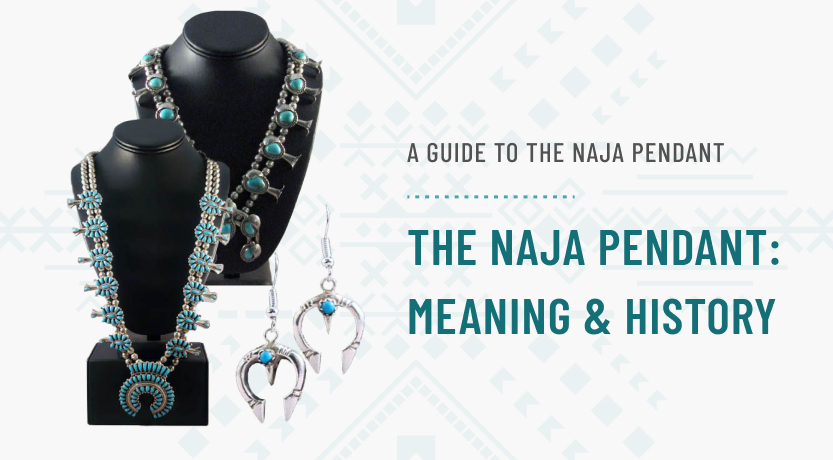
For over a century, the Navajo and Zuni peoples have crafted shining crescent-shaped pendants called naja out of silver. Sometimes naja are worn on their own, but they are most frequently seen hanging from the center of a Navajo squash blossom necklace.
The Origin of the Naja
In The Beauty of Navajo Jewelry, Theda Bassman states that:
“The Navajos greatly admired the silverwork of the early Spaniards, who loved personal adornment that was lavishly decorated with silver. One example is the naja, a crescent-shaped pendant appearing on the bridles of Spanish horses, originally used by the Moors of North Africa and eventually copied by the Navajos. Today, the naja is still used as a pendant on squash blossom necklaces and other jewelry.” (Bassman, 6)
The naja was first seen in North America as the Spaniards moved into the West in the late 16th century. The Navajo people may have adopted the naja from the Spanish people themselves. The naja was an amulet on the bridle of a horse to protect the horse and rider from “the evil eye.”. The Zuni and Hopi Pueblo peoples adopted the naja and include it in their designs.
The Naja in Silver Jewelry
The Navajo acquired metalworking skills from Mexican blacksmiths and started working in silver around 1875. It wasn’t long before the Navajo and Zuni were hammering or casting silver to make naja pendants similar to the ones we see today. These pendants featured stamped or chiseled decorative elements and were attached to a necklace with a hook, loop, or bail. Some featured a pin clasp that allowed the jewelry to be worn on fabric as a brooch. The Navajo created their first necklaces out of silver in the 1870s and started using lapidary techniques like cluster work, petit point, needlepoint, and inlay in the 1880s.
Variations in the Naja Design
Through the years, the naja form has inspired many Native American artists, who interpret it according to their own unique visions. They contribute different stylistic flourishes to the crescent shape by closing its ends or crossing it with double and triple bars. Some silversmiths have placed hands, which may reference the Moorish “hands of Fatima,” at each point of the crescent. The Navajo silversmiths have even used the “Rainbow Man,” who is a symbol of protection, as the naja. Many najas feature a decorative stone or charm that hangs freely from the center of the pendant. Today, you can find the naja and its adjoining squash blossom necklace in a variety of styles. They may be plainly wrought in silver, hand-tooled, or adorned with turquoise and other stones.
The Naja is an Adornment for the Ages
The naja is one of the most beautiful and recognizable emblems found in Native American silver jewelry. Whether it’s simple or elaborate, this symbol carries a timeless, elegant mystique that brings the spirit of the American West into the present day.
Sources:
Bassman, Theda. The Beauty of Navajo Jewelry. United States, Kiva Pub., 1997.
(accessed via Google Books 04/14/2023 https://www.google.com/books/edition/The_Beauty_of_Navajo_Jewelry/_o7Y2neHS4kC?hl=en&gbpv=0)


A small correction may, respectfully, in order. Alexander the Great’s horse Bucephalus wore a Naja on his forehead.
Holly, it is true about Alexander the Great, however, he had no impact on the Native Americans. Thank you for your comment. Patty. Kachina House